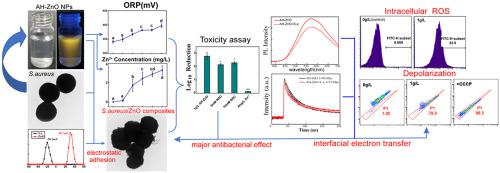Journal of Hazardous Materials ( IF 12.2 ) Pub Date : 2021-05-07 , DOI: 10.1016/j.jhazmat.2021.126013 Mengru Du 1 , Wenbo Zhao 2 , Ruonan Ma 1 , Hangbo Xu 1 , Yupan Zhu 1 , Chongxin Shan 2 , Kaikai Liu 2 , Jie Zhuang 3 , Zhen Jiao 1

|
Waterborne diseases caused by pathogenic microorganisms pose severe threats to human health. ZnO nanoparticles (NPs) hold great potentials as an effective, economical and eco-friendly method for water disinfection, but the exact antimicrobial mechanism of ZnO NPs under visible-light illumination is still not clear. Herein, we investigate the visible-light-driven photocatalytic inactivation mechanism of amino-functionalized hydrophilic ZnO (AH-ZnO) NPs against Staphylococcus aureus (S. aureus) in aqueous environment from the perspective of electron transfer theory. The results show that the antibacterial effects of AH-ZnO NPs are dependent on the AH-ZnO NPs concentration and treatment time. The bulk ORP value and released Zn2+ concentration in AH-ZnO NPs solutions increase with AH-ZnO NPs concentration. The SEM and intracellular protein leakage results indicate that AH-ZnO NPs can adhere to S. aureus surface without causing obvious cell membrane disruption. The photoluminescence (PL) intensity and fluorescence lifetime of AH-ZnO NPs are remarkedly decreased after adding S. aureus, which confirms the electron transfer from S. aureus to AH-ZnO NPs. Moreover, the ΔPL intensity is closely correlated with the inactivation efficiency, demonstrating that the interfacial electron transfer in S. aureus/AH-ZnO NPs composites contributes to the antibacterial activity, which is speculated to disrupt the normal respiratory electron transfer chain of S. aureus, thereby causing intracellular ROS generation, cell membrane depolarization and eventually apoptosis-like death.
中文翻译:

基于金黄色葡萄球菌/氧化锌复合材料中的界面电子转移,亲水性氧化锌 (ZnO) 纳米粒子在水环境中可见光驱动的光催化灭活金黄色葡萄球菌
由病原微生物引起的水传播疾病对人类健康构成严重威胁。ZnO 纳米粒子 (NPs) 作为一种有效、经济和环保的水消毒方法具有巨大的潜力,但 ZnO NPs 在可见光照射下的确切抗菌机制尚不清楚。在此,我们从电子转移理论的角度研究了氨基官能化亲水 ZnO (AH-ZnO) NPs在水环境中对金黄色葡萄球菌( S. aureus )的可见光驱动光催化失活机制。结果表明,AH-ZnO NPs 的抗菌作用取决于 AH-ZnO NPs 的浓度和处理时间。本体 ORP 值和释放的 Zn 2+AH-ZnO NPs 溶液中的浓度随着 AH-ZnO NPs 浓度的增加而增加。SEM 和细胞内蛋白渗漏结果表明 AH-ZnO NPs 可以粘附在金黄色葡萄球菌表面而不会引起明显的细胞膜破坏。添加金黄色葡萄球菌后,AH-ZnO NPs 的光致发光(PL)强度和荧光寿命显着降低,这证实了电子从S. aureus转移到 AH-ZnO NPs。此外,ΔPL强度与灭活效率密切相关,表明金黄色葡萄球菌/AH-ZnO NPs复合材料中的界面电子转移有助于抗菌活性,据推测这会破坏正常呼吸电子转移链金黄色葡萄球菌,从而导致细胞内 ROS 生成、细胞膜去极化并最终导致细胞凋亡样死亡。











































 京公网安备 11010802027423号
京公网安备 11010802027423号